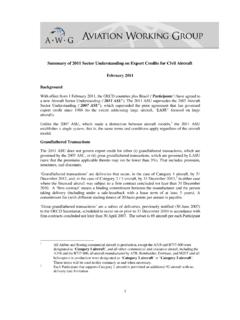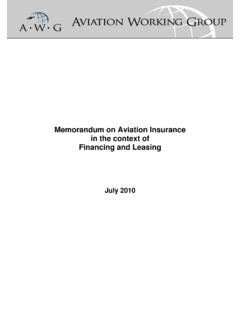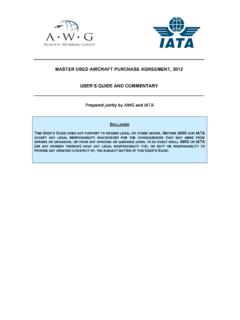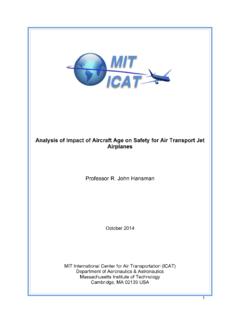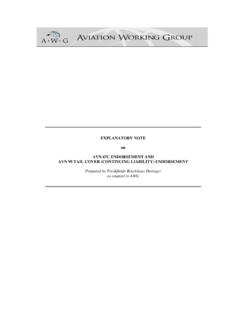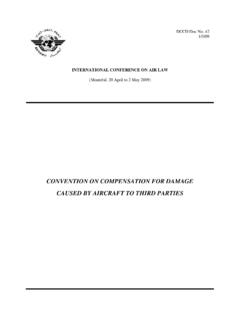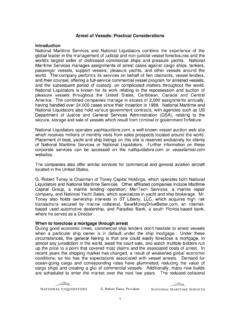Transcription of Regulatory Policies and Principles Applicable to …
1 Regulatory Policies and Principles Applicable to aircraft leasing EXECUTIVE SUMMARY I. Development and importance of aircraft leasing aircraft leasing has rapidly developed and expanded over the last 50 years. Prior to the 1970s barely 1% of all commercial aircraft were subject to operating leases. Today, that number is approximately 40%. The growth of leasing can be attributed to a combination of practicality and efficiency: leasing facilitates the efficient use and redeployment of aircraft , regardless of age, size, type or location.
2 leasing supports modern and fuel efficient air transport. It provides an attractive source of financing and/or supply of aircraft in a capital intensive industry, while providing operational and fleet planning flexibility to operators. It also provides financiers and investors with an opportunity to secure lending or investment in the aviation industry against a diversified portfolio of aircraft equipment, which aircraft leasing companies are well placed to provide. II. Principles of aircraft leasing The core Principles underlying aircraft leasing transactions are as follows: Separation of ownership from control there is a basic split between ownership (lessor/ financier) and operation, use, and control (operators).
3 Operational responsibility and risk resides with operators, who are best positioned to minimise and manage such responsibilities and risks. Efficient redeployment of aircraft the basic economics of the leasing industry assume continuous use of aircraft , which, in practical terms, means the ability to promptly redeploy aircraft after the term of a lease or an early termination. Legal or other impediments which delay redeployment add costs that are passed through the system, adversely affecting all parties, including operators and passengers.
4 Certainty of rights and responsibilities leasing contracts are complex instruments entered into by sophisticated parties, usually represented by legal advisers, in a competitive marketplace. The lease agreement and related contracts set out the respective rights and obligations of the parties. It is essential that these rights and obligations are enforceable on the terms set out in such contracts so that the allocation of risk is in line with what has been agreed between, and is expected by, the parties. Greater certainty in respect of risk allocation creates greater efficiency in the aircraft leasing market and more attractive pricing for aircraft operators.
5 III. aircraft leasing and Regulatory policy Key aspects of Regulatory policy which follow from the foregoing Principles are as follows: Commercial and insolvency law must (i) respect property rights in aircraft , (ii) facilitate the ability to promptly redeploy aircraft , both in the ordinary course and where an aircraft must be repossessed, and (iii) enable the enforcement of leases and related contracts, as drafted, in each case, inside and outside insolvency. Liability law must not hold lessors liable for loss or damages to passengers or third parties on account of operational risks.
6 Lessors cannot control these risks: operators operate aircraft and regulators regulate that operation. This allocation of risk is reflected in the universal practice of operator indemnities in favour of lessors in respect of operational risk. There is no place for rules of owner-based strict liability or other theories that hold lessors liable for operational risk. 2 Insurance law must permit an operator effectively to secure insurance cover for property loss and liability risk for the benefit of lessors.
7 That is universal practice, given its efficiency. Such insurance, in addition to the above-noted operational indemnities, is the commercially required method of addressing operation-based loss and liability. In particular, lessors must remain insured in cases of an operator s breach of its insurance contract or any other condition that would invalidate cover for the operator. Lien law must not permit a lessor s ownership or property rights in an aircraft to be adversely impacted by liens or detention caused by an operator s actions or omissions.
8 Parties dealing with operators, including airports and aviation authorities, are positioned to self-protect against non-performance by operators without recourse to aircraft owned by third parties. So-called super-priority liens and related rights of detention, in effect, expropriate property of innocent third parties. Regulation relating to cross-border transferability of aircraft must permit efficient redeployment of aircraft to new operators. A high percentage of aircraft are re-registered in different countries several times during their useful lives, meaning there is a need for efficient cross-border transferability rules.
9 Regulatory overlap and duplication among national systems should be minimised and eventually eliminated. Importation rules must be based on risk assessment, not aircraft age. Accounting rules must ensure that accounting treatment is in line with and reflects the economic realities of the leasing transactions, considering the contract as a whole and rights and obligations of the parties thereto. 3 I. DEVELOPMENT AND IMPORTANCE OF aircraft leasing A brief history of aircraft leasing 1 The vast majority of early aircraft operators were national carriers with significant government support.
10 As such, most early financing arrangements were based on low default risk, the supported operator owning the aircraft and using it for the entirety of its useful life. 2 The advent of jet powered aircraft resulted in competitive aircraft manufacturers, each hoping to secure transatlantic transport market share. However, not all airlines were in a position to acquire large amounts of capital intensive aircraft equipment, and, as a result, a new market was established for intermediaries who were willing to take the risks and rewards of owning and leasing aircraft .
